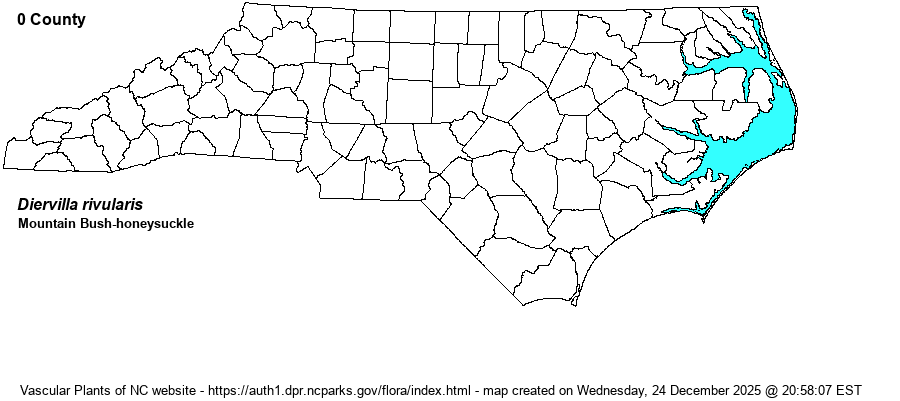| Author | Gattinger | |
| Distribution | Formerly considered to have occurred at rather high elevations in the Mountains -- in Mitchell and Yancey counties. However, a paper by Mathews, Wheeler, and Silveira (2025) showed that this species essentially occurs just in the Cumberland Mountains/Plateau in TN and south to northwestern GA and northern AL. Previous reports in NC might "represent populations of hybrid origin [sessilifolia x rivularis] from glacial periods when populations of all three taxa are hypothesized to have shifted and may have come into contact" (above paper).
Range is limited to east-central TN south only to northwestern GA and northern AL.
| |
| Abundance | Not known from NC, based on the 2025 study. Thus, the website editors now consider the State Rank as SRF [Reported Falsely]. | |
| Habitat | This species occurs along rocky stream banks, bluffs, and cliffs, often where shaded or cool – mostly not in as exposed or as dry sites as Diervilla lonicera. Along streams, seems to favor areas with some amount of scour. | |
| Phenology | Blooms from June to August, and fruits from August to October. | |
| Identification | This deciduous shrub has a similar growth pattern to the other two Diervilla species, growing only to 2-3 feet tall with widely spreading stems. The narrowly ovate to lanceolate opposite leaves, with serrated margins, are sessile and grow to 4 inches long, but the leaves have essentially no petioles (i.e., are sessile), such that the leaves basically come directly off the stem. It has light yellow flowers in clusters in axils of the outer leaves or at branch tips, as do the others in the genus. However, this species is separated from the much more widespread D. sessilifolia by it quite pubescent leaves and twigs, as well as the pedicels and bracts of the flowers. | |
| Taxonomic Comments | RAB (1968) and a few other references had this taxon as a variety of D. sessilifolia, as D. sessilifolia var. rivularis. Most references, especially recent ones, however, give full species status to this taxon.
Weakley (2020) splits out the family Diervillaceae from Caprifoliaceae, but provides no taxonomic basis for this move. We will await further developments. | |
| Other Common Name(s) | Hairy Bush-honeysuckle, Hairy Southern Bush-honeysuckle, Georgia Bush-honeysuckle, Riverbank Bush-honeysuckle. Hairy Bush-honeysuckle would be the best name, and certainly would better describe the species, as all three bush-honeysuckles are found primarily in mountains. | |
| State Rank | SRF | |
| Global Rank | G3 | |
| State Status | T [--] | |
| US Status | | |
| USACE-agcp | | |
| USACE-emp | | |

